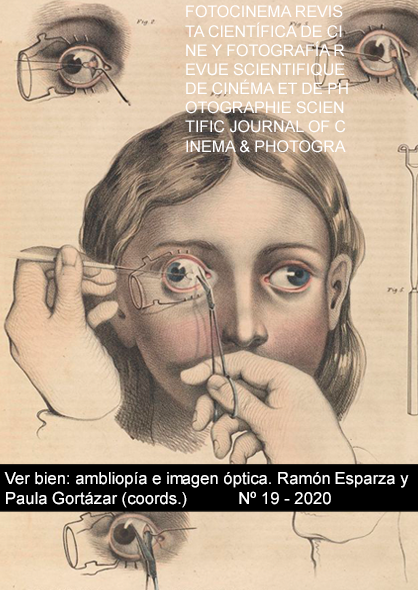Avant-Garde Photographics: Multidisciplinary Precedents Advancing Transdisciplinary Arts into the New Century
DOI:
https://doi.org/10.24310/Fotocinema.2019.v2i19.6646Keywords:
avant-garde photographics, proto modern photography, multidisciplinary, transdisciplinary, modern photomontage, modern art, early modern history of photography.Abstract
The multidisciplinary advent of avant-garde photographics in the early 20th century was a search for new directions. Ongoing transformations in innovations established the proto-modern era with European avant-gardes. Advancing new forms of photographic expression with an unprecedented breadth and depth of diversity. Setting precedents for transdisciplinary art practices and strategies, which continue to move past traditions, boundaries, and limitations today.
Individual contributions broadened new forms of proto modern photography -- with and beyond the camera and chemical darkroom. Support of emerging technologies, modern materials and media advanced the formative evolution of modern art across disciplines. Inventions from proto modern photography including modern photomontage, photograms, advances in cinema, exhibtion design, and color, expanded by modern printing methods, explored cross influences between media and materials.
Avant-garde photographics coexisted across classic boundaries that separated traditional art mediums by their limitations. Abandoning conventional art forms for inventive photographic possibilities.
Today transdisciplinary art exists without traditional subjects or genre. Moving the multimedia past into photographic ideas without category, art-historical narratives or divisions. Dichotomies and debates between real and abstraction, subjective and objective, documentary and constructed veracity, the elimination of definitions between original and copy, move avant-garde photographics in the 21st century beyond the modern era.Downloads
Metrics
Publication Facts
Reviewer profiles N/A
Author statements
Indexed in
-
—
- Academic society
- N/A
- Publisher
- Universidad de Málaga
References
Derkusova, I. (1972). Klucis. Gustav; Latvijas M?kslas Nacion?l? Muzeja Kolekcijas Zin?tniskais, Complete Catalogue of Works in the Latvian National Museum of Art, Volume II, Riga.
Henye, R.; Neusüss, F. M. with Hattula Moholy-Nagy (2009). Moholy-Nagy, The Photograms, Catalogue Raisonné, Ostfildern, Germany: Hatje Cantz Verlag.
Jackson, J.B. (1980). The Necessity for Ruins, Amherst: University of Massachusetts Press.
Lavrentiev, A. (1994). Vladimir Mayakovsky, Pro Eto, Berlin: Ars Nicolai.
Lissitzky-Küppers, S. (1992). El Lissitzky, Life, Letters, Texts, London: Thames and Hudson, 1980.
Rodchenko, A. (2003). Changing the angle of observation from techniques to art, Paris, 1925. In Alexander Rodchenko, Abangoardiako argazkigintzea, fotomontaketea eta zinemagintzea (Modern photography, photomontage and film), Bilbao: Fundación Bilbao Bizkaia Kutxa.
Shneer, D. (2010). Picturing Greif: Soviet Holocaust Photography at the Intersection of History and Memory. American Historical Review, February.
Strand, P. y Stieglitz, A. (1917). Photography. Camera Work, June, Núm. 49-50.
Tuluzokova, G. (2007). Nikolai Fechin, St. Petersburg.
Yates, S. S. (2014). Gustavs Klucis and the Avant-Garde: Proto modernism in photographic ideas for the 21st century. In Derkusova I.: Gustavs Klucis, K?da Eksperimenta Anatomija, Anatomy of an Experiment, Riga: Latvian National Museum of Art, pp. 55-81.
Yates, S. S. (2016). Proto Modernios Fotografijos Aspektai: Avangardo Isotija Rusijoje, Europoje ir Centrin?je Azijoje. (Facets of Proto Modern Photography: History of Avant-Garde in Russia, Europe and Central Asia). Art History & Criticism, Number 12, Vytautas Magnus University, Research Council of Lithuania, Kaunas.
Yates, S. S. (2018). Byzantine Icons to Transdisciplinary Innovations in Modern Photomontage. Lecture given at: The ARCHETYPE and universal in the art of the Christian world from Antiquity to the present: painting and monumental-decorative art, architecture and spatial environment. MGHPA, Moscow State Art and Industry Academy, pp. 155-166.
Yates, S. S. (1984). The Essential Landscape with essays by JB Jackson, Albuquerque: University of New Mexico Press.
Downloads
Published
How to Cite
Issue
Section
License
All contents published in Fotocinema Revista científica de cine y fotografía are protected under the Creative Commons Attribution-NonCommercial-ShareAlike 4.0 International (CC BY-NC-SA 4.0) license. All about this license is available in the following link: <http://creativecommons.org/licenses/by-nc-sa/4.0>
Users can copy, use, redistribute, share and exhibit publicly as long as:
- The original source and authorship of the material are cited (Journal, Publisher and URL of the work).
- It is not used for comercial purposes.
- The existence of the license and its especifications are mentioned.
There are two sets of authors’ rights: moral and property rights. Moral rights are perpetual prerogatives, unrenounceable, not-transferable, unalienable, imprescriptible and inembargable. According to authors’ rights legislation, Fotocinema. Revista científica de cine y fotografía recognizes and respects authors moral rights, as well as the ownership of property rights, which will be transferred to University of Malaga in open access. The property rights are referred to the benefits that are gained by the use or the dissemination of works. Fotocinema. Revista científica de cine y fotografía is published in an open access form and it is exclusively licenced by any means for doing or authorising distribution, dissemination, reproduction, , adaptation, translation or arrangement of works.
Authors are responsable for obtaining the necessary permission to use copyrighted images.














13.png)



